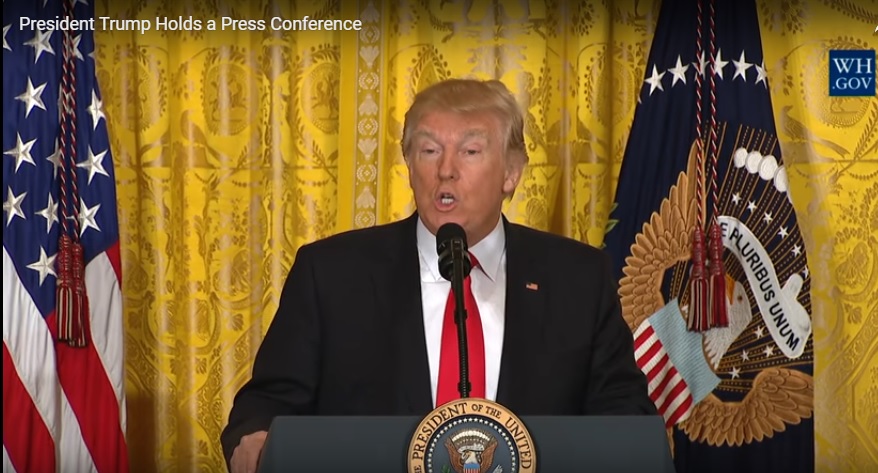
President Donald Trump (Courtesy of the White House)
While Trump tariffs could lead to some strong short run gains, the long run effect could be devastating to the very industries it is trying to protect.
By Suhail Tahir
President Donald J. Trump’s trade war is not a new concept to the American people. In the 1960s, President Lyndon B. Johnson instituted a tariff called “The Chicken Tax” against potato starch, dextrin, brandy and light trucks, and, much like Trump’s trade war, a lot of the motivation behind the tax was political.
The “Chicken Tax” was implemented in response to European worries about the United States chicken industry gaining a large share of the European chicken market and drastically lowering European prices. Because chicken had been considered a delicacy in Europe, the European chicken farmers were able to maintain high prices.
But with the large influx of chickens from the United States, European chicken farmers were hurt. Eventually, European governments took notice and accused the United States’ chicken industry of dumping the chicken at lower prices and started instituting price controls, quotas, and tariffs. The effect of these actions caused the United States’ chicken farmers to lose about a quarter of their chicken sales.
READ: US-India trade relations may be less strained under Biden (January 4, 2021)
So, in response, Johnson issued an executive order putting an ad-valorem tariff of 25% on certain imports, including light trucks, each targeting big industries in countries that had put a tax on American chicken. While Johnson labelled the tariff as a response approved under GATT — General Agreement on Trade and Tariff, a precursor to the World Trade Organization — principles, it was later discovered that Johnson had instituted the tariff to protect the domestic automobile industry to prevent an automobile worker strike as the presidential election was coming up.
The reason light trucks were included in the tariff was to target the German Volkswagen trucks. As a result of this tariff, German automobile imports dropped by about a third and were soon almost non-existent. The long-term implications of this tariff are that they directly affect any foreign automobile industry trying to export trucks to the United States.
With the implementation of the tariff, domestic automobile producers were now able charge more for their trucks. With the near absence of foreign competition, the supply of cars in the domestic market went down, allowing domestic automobile producers to charge higher prices. In terms of overall welfare of the United States economy, since the United States’ automobile industry is a large player in the global automobile industry they could gain from instituting a tariff, and they definitely did. Profits of domestic automobile manufacturers soared.
Another advantage of the tariff is that producers of intermediate outputs related to truck manufacturing like steel also benefit from the increase in profits. However, many argue that profits should not be the only point to look at in considering the effects of tariff.
READ: No thaw in US-India tariff war (June 19, 2020)
Modern critics of the tariff argue that domestic automobile manufacturers are not focused on innovative and competitive designs and are only focused on maximizing profits from the tax. Their worries stem from the fact that increased globalization trends like lower transportation costs and increased productive efficiency could lead to the entrance of foreign truck manufacturers into the domestic industry, hurting domestic manufacturers whose designs may not be able to keep up with the more competitive world market.
Also, if the tariff were ever abolished or even reduced, domestic manufacturers, like Dodge, whose lack of focus on improving trucks could end up getting hurt by the increased supply of trucks from foreign manufacturers.
One interesting outcome of the Chicken tax is the increase in Foreign Domestic Investment. Because of the high tariffs, foreign automobile manufacturers found it profitable to create assembly plants in the United States and Canada. But ever since the tax has been put in place, United States-based automobile manufacturer have found a way to profitably offshore the production of cars and import them.
Because the tariff only targets “light trucks,” companies like Mercedes and Dodge would manufacture the components of their trucks outside the United States and then import them unfinished to be assembled at a domestic plant. Companies like Ford would buy “passenger vans” from Turkey and then strip it of the parts that made it a passenger van to turn it into a “light truck.” Ultimately, the tariff is very good for the United States labor force either way because both methods require companies to invest in domestic assembly plants.
The previous analysis seems to have one giant blemish in that it does not look at the effect of the chicken tax on the chicken industry. But the purpose of the chicken tax was not to help the chicken industry recover, it was to formally retaliate against European economies and informally help the United States automobile industry and in the historical short run of the tariff, it accomplished just that, much like Trump’s trade war. While President Trump’s tariffs could lead to some strong short run gains, the long run effect could be devastating to the very industries it is trying to protect.



